Eating on Crete
Not to get too San Franciscan, but we loved Crete’s focus on fresh, local food. The area is still heavily agricultural, and you can find an amazing variety of produce at roadside stands almost anywhere on the island. The most impressive display that we saw, however, was at Chania’s Saturday open air market. It’s a farmers’ market that even the Bay Area would envy, with dozens of vendors selling fruit, vegetables, homemade olive oil, raki (liquor made from the leftovers in the winemaking process– we strongly preferred it to the Turkish stuff, which tended to be anise-flavored), yogurt and cheeses, and fresh eggs, meat and fish. And it’s remarkably affordable, at least by U.S. standards.
We found it easy to strike up conversations with the locals– the people we met were warm, friendly, and seemed genuinely gratified to hear that we were taking the time to see a lot of the island, as opposed to just parking it in a resort. If you do this multiple times, you’re almost guaranteed to hear about the wonders of the Cretan diet: Apparently a study showed that natives tend to live exceptionally long, healthy lives, and the natives themselves put this down to their diet, especially the olive oil. It’s impossible to drive for more than a few miles (or walk more than a city block) without seeing a roadside stand or shop touting its Cretan olive oil–often homemade. According to some highly scientific internet research that I just conducted, citizens of Crete may consume as much as 35 liters of olive oil per year, compared to a measly 1 or 2 per U.S. citizen.
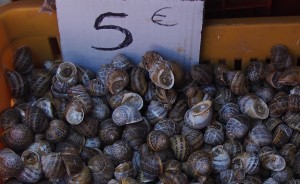
Snails! We tried them a few days later, cooked in a tomato and herb sauce. Not bad, but not a must-have-seconds experience either
In Crete it’s very easy to find inexpensive apartment-style rentals, even for just a few nights. As a result, we had kitchenettes (of varying functionality) in each place. Every day we hunted down farmstand fruit and locally made thick, delicious yogurt (usually sheep’s milk) for the following day’s breakfast. It was an indulgence to have slow mornings at “home,” and we took full advantage.
Our Favorite Tavernas
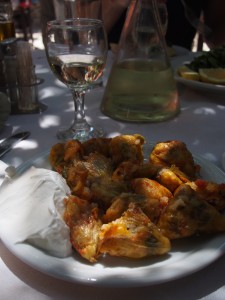
Typical taverna lunch– zucchini blossoms stuffed with rice, tomatoes and other deliciousness and a carafe of the house white
Although we ate breakfast and one or two simple dinners at home, the majority of our meals were at small, casual restaurants called tavernas. No matter how small the village, it’s almost guaranteed to have one or two tavernas serving a typical array of Greek specialties. Our experiences varied, and of course we found a few favorites, but across the board we enjoyed the taverna scene. The waiters (often the owners) were friendly and funny, pushing favorite dishes, serving up huge portions and comically inexpensive carafes of the house wines, and providing free desserts and, dangerously, bottles of raki at the end of the meal.
We spent several long afternoons and evenings sipping wine or raki, playing backgammon or just people watching, as tavernas tend to be local gathering places. Doing so is made easier by the fact that you’re essentially expected to linger– you won’t get the check until you request it, and doing so immediately after finishing your food often brings raised eyebrows (and the uncomfortable feeling of being perceived as an overscheduled American).
With so many places to eat (and particularly as we stayed all over the island), we generally resisted the temptation to revisit the same spots. There were two exceptions: First, Leventis in tiny Pano Stalos, featuring a huge patio with a beautiful view over the mountains and a menu with lots of small plates that’s perfect for long, relaxed dinners; and second, Parasia Rakadiko,near Vamos village (but hard to find–we had to ask in town for directions) run by a really friendly and charming family, offering probably the best lamb we had in all of Crete. It was cooked in thyme and honey we’re still talking about it a month later. We also bought some of their homemade raki for nightcaps– it came in a large plastic bottle and cost all of four euros.
Cretan Winery Visits
Back to the wine. Cretans have been making wine for at least 3,500 years–ancient wine presses and excavated palace paintings provide evidence of viticulture there during the Minoan Empire. Although we tried house wines (often homemade, always drinkable, sometimes pretty good–we are not that discerning) at most of our meals, we also made time to check out a few of the island’s more established wineries. Of the four places we visited, we’d recommend three: Manousakis, Dourakis, and Douloufakis. All offered quick, casual tours and informal, friendly tastings. We’d arranged for light lunches at Manousakis and Dourakis as well, which I’d definitely recommend.
All three wineries offered the chance to try a number of Greek varietals (some native to Crete) that we hadn’t had before, such as Vidiano and Vilana (whites), and Kotsifali and Liatiko (reds). Had this been a different sort of trip, we might have ordered a few cases to be shipped home. As it was, we contented ourselves with picking up a few bottles here and there to enjoy on our various rented balconies and moved on.


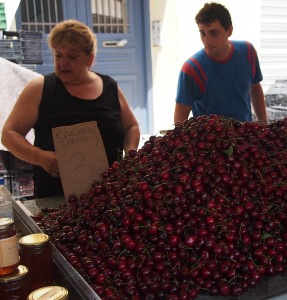
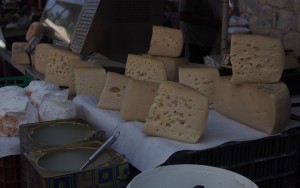
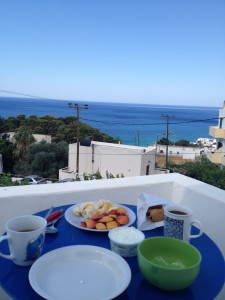
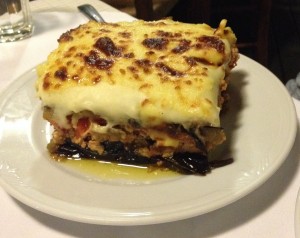
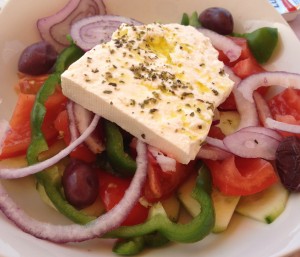
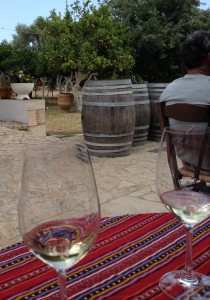
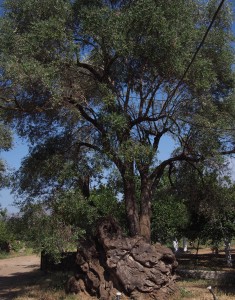
Glad to know that, should I get to Crete, snails are not a must do. 🙂 Sherrie
Hello!
I would like to inform you that Douloufakis Winery at Dafnes, Crete, Greece has changed its domain name.
Could you change the link in your article from “http://www.cretanwines.gr/en/”
to “https://www.douloufakis.wine/en/”?
Thank you so much!